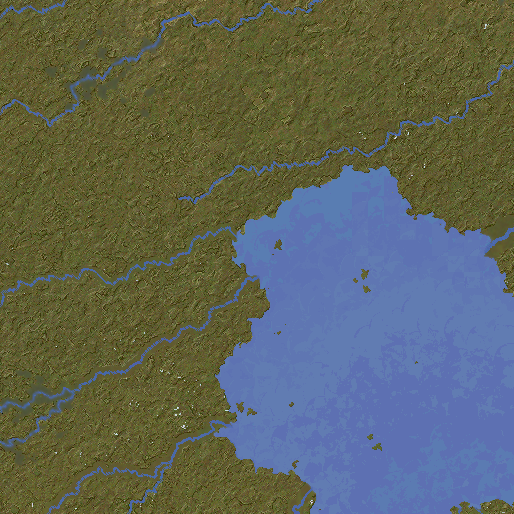In my last post I talked about (yet another) new way of making coastlines better: by creating a mask for them using a simple diamond-square algorithm, and then filling in the terrain afterwards. It occurred to me that something similar could work for lakes, too.
Lakes are currently created at regional level via a horrendously complex process. Originally, I treated lakes as simply part of the regional terrain, using the diamond-square algorithm to generate the lake beds using the actual elevation values taken from the global map. This didn't work well, so I changed this to a more complicated method that traces the edge of the tiles of the lake and then disrupts it, to create a mask, and then generates new lake bed to fill it. This works fairly well most of the time. However, sometimes it goes wrong, for reasons I can't diagnose, and produces lakes with square borders or leaves them out entirely.
But it occurred to me that I could just adapt my new coastlines approach. If I'm generating a mask for the shape of the lakes before calculating the elevation of their beds, I can make that mask using the diamond-square algorithm, just as with the coastlines. The key realisation is that this algorithm doesn't have to be seeded with elevation values from the global map. It can be anything. This allows me to give it values that tend to produce good lake shapes, and then fill in the depths afterwards.
This gives results like these:
This method has several advantages over the previous one. It's much simpler and requires far less code. It also seems not to go wrong, which also helps. Moreover, this method can render lakes of any size. With the old method, for each regional map, UW would create the entirety of any lakes that were only partially on the map, as in the last image above. This meant there was a limit to how big they could be (and even the larger ones within that limit tended not to work properly). This new method doesn't do that, however. It just creates the bit of lake being shown and ignores anything outside the borders of the current region. This means we can have very large lakes. It also means that we can have very large ergs (areas of sandy desert) and salt pans, because the program treats these as weird lakes. So where before these couldn't get very extensive, we can now have immense sandy deserts like this one:
Indeed there's nothing to stop us now from having Arrakis-style planets with ocean-sized deserts of sand. As with everything, we don't want that to happen too often, but anything that (believably) increases the range of possibilities is good. Some more adjustments to this new system are needed, but it seems to be fairly robust so far, so I'm quite pleased with it.












